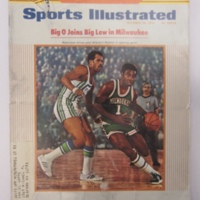Browse Exhibits (1 total)
Black Athletes "on the Ropes" with Masculinity

With its first issue published in 1954, Sports Illustrated has gone through decades of transformation. When it first began, its creator—Henry Luce— hoped to expand the types of publications distributed by Time Inc. After Andre Daguerre took over as managing editor in 1960, the popularity of SI grew. [1] They covered all sporting events from basketball and tennis, to skiing and football. With their stories and photos, they allowed their readers to get a glimpse into the lives of American athletic heroes. SI issues went beyond just the plays of the game, game statistics and quality of the players. The articles delivered first-hand accounts of what motivated and frightened the athletes. The articles, whether they meant to or not, served to humanize the athletes and helped sports audiences identify with them.
Three specific articles— “A Rueful Dream Come True,” “Still Too Tender to Be a Tiger” and “He Moves Like Silk, Hits Like a Ton”— were all published towards the end of the 1960s into the early 70s and highlight the stories of two boxers: Muhammad Ali and Floyd Patterson. When analyzed together, not only do the articles detail the social and political transformations in the boxing world, they also comment on the boxers’ masculinity and what was required of athletes to be recognized as serious, All-American, professionals. The items in this collection exhibit how different language is employed by the authors when describing the careers of Ali and Patterson. As a result, Ali is framed as true athlete and hero, while Patterson is framed as a weak, emotional person not fit to fight in the ring.
—————
1. "Sports Illustrated". Encyclopædia Britannica. Encyclopædia Britannica Online.
Encyclopædia Britannica Inc., 2016. Web. 02 Nov. 2016
<https://www.britannica.com/topic/Sports-Illustrated>.